Weekend DIYs are trending for good reason—and yard art offers one of the most satisfying payoffs. With just a few repurposed items, a splash of paint, or clever placement, you can instantly boost curb appeal and give your outdoor space character without spending much. From quirky signs to upcycled planters and sculptural pieces, these ideas blend creativity with functionality in ways that feel fun and doable. No professional tools or big budgets required. This guide rounds up the most-loved, easy-to-make yard art ideas people are actually using right now, offering you real inspiration to personalize your garden in a meaningful way.
Painted rock garden markers
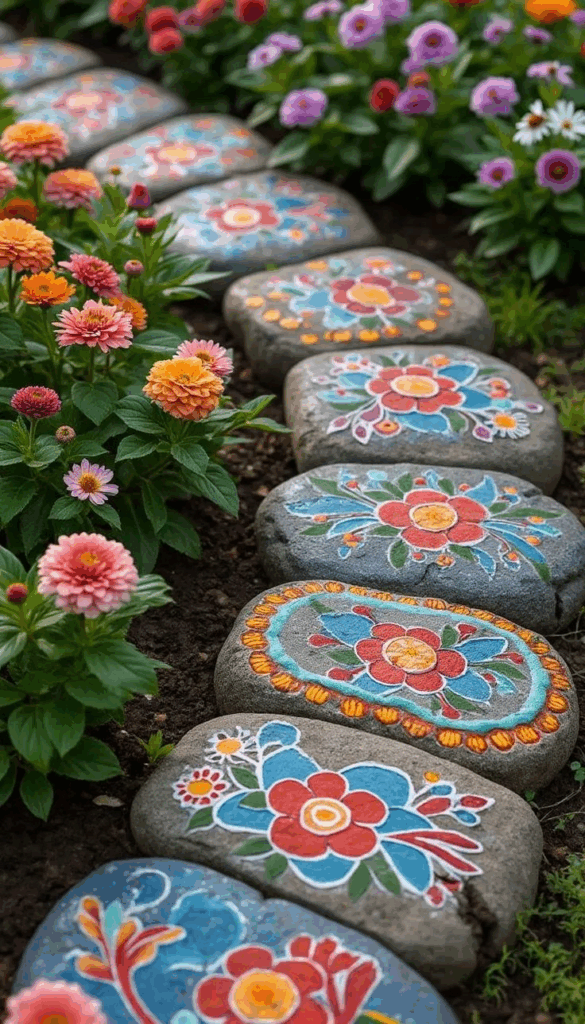
Colorful stone markers offer a fun, low-cost way to personalize your garden layout while helping identify plant types or zones. Smooth river rocks or flat landscaping stones make the ideal base for painting. Using outdoor acrylic paint and a weatherproof sealant, you can customize each rock with plant names, decorative patterns, or whimsical characters. This not only enhances the visual charm of vegetable beds and flower borders but also serves a functional role in labeling herbs or seasonal blooms. Hand-painted rock labels are especially helpful in raised beds or community gardens where quick identification matters.
Many DIYers also add humorous quotes or garden puns to their markers, injecting personality into the landscape. For kids, it’s an enjoyable weekend project that fosters both creativity and a connection with nature. Placing the rocks at the base of each plant or along garden paths allows them to stand out while resisting wind or foot traffic. Over time, the sealed paint holds up well against weather and UV exposure. Whether for functional plant IDs or decorative touches, painted rock garden markers offer a durable and charming way to upgrade any outdoor space without much cost or effort.
Bottle-cap flower stakes
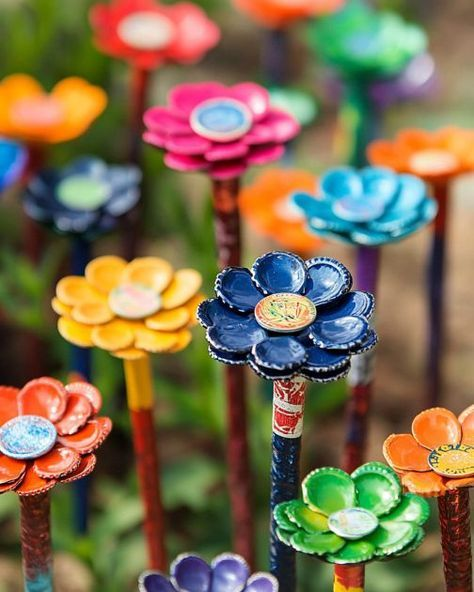
Repurposed bottle caps can bloom into playful floral sculptures perfect for flowerbeds or veggie patches. Collect various metal or plastic caps in bright colors, and attach them to a metal rod or wooden dowel using epoxy or small nails. Arranging multiple caps in concentric circles mimics the petals of daisies or sunflowers, while contrasting colors in the center add realistic flair. For added dimension, flatten some caps and curl the edges outward using pliers, creating texture that glints in the sun.
Once assembled, seal the finished piece with a clear rust-resistant coating to extend its lifespan outdoors. These bottle-cap flowers make excellent focal points around garden corners, particularly when real blooms are off-season or still budding. Taller stakes work well tucked among shrubs or vegetables, offering a playful contrast.
You can also personalize these with glitter accents, small beads, or even painted leaf shapes at the stem. Many DIY gardeners incorporate solar lights into the center, transforming them into night-friendly art. Kids can get involved too, turning recyclables into cheerful decorations. This project combines eco-friendly reuse with artistic expression, giving otherwise discarded items a fresh life while brightening outdoor spaces.
Upcycled bicycle wheel sculptures
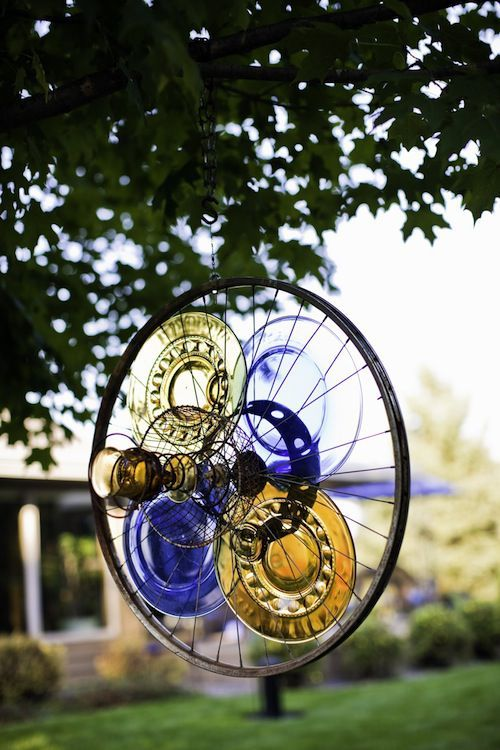
Old bicycle wheels offer an industrial-meets-whimsical canvas for DIY yard art that’s both durable and visually compelling. With their built-in circular symmetry, spokes, and metal finish, bike wheels lend themselves to a variety of artistic directions—everything from kinetic spinners to rustic flower patterns or solar-lit mandalas. Mount the wheel vertically on a metal stake, attach to a fence, or suspend from tree branches to allow movement in the breeze.
To embellish, weave ribbons, colored wires, or glass beads through the spokes. Some DIYers attach tin flowers, metal cutouts, or even mosaic tiles to give each wheel a distinct theme. You can also spray paint the rims in contrasting shades for added dimension. The end result becomes a focal piece that adds structure and creativity to blank corners or bare walls.
For kinetic versions, layer two wheels on a single axis so one spins independently in wind, enhancing movement and visual interest. With minimal tools—usually just pliers, zip ties, paint, and sealant—you can produce bold results that hold up year-round. This kind of sculpture pairs especially well with vegetable gardens, gravel beds, or xeriscapes, contributing personality while keeping materials out of the landfill.
Hanging utensil wind chimes
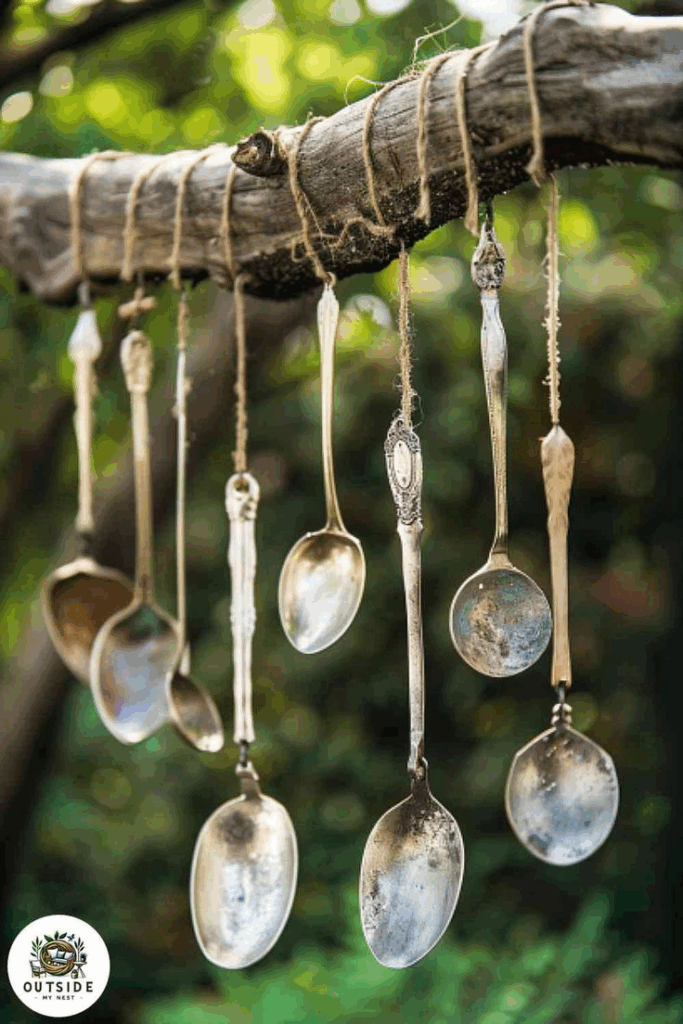
Old forks, spoons, and ladles take on a second life as melodic, shimmering wind chimes. Begin by collecting mismatched utensils from thrift stores or your own kitchen. Drill small holes into the handles and use fishing line or sturdy string to suspend each piece from a wooden branch, driftwood, or metal hoop. The variation in utensil sizes creates pleasant tones when they tap in the breeze, offering both charm and gentle ambiance.
Hammering the bowls of spoons slightly flat or curling fork tines outward adds visual flair. Some crafters etch designs or patterns onto the metal using stamping tools, while others use outdoor acrylic paint for a splash of color. For an added personal touch, include keys, beads, or tiny bells between the utensils.
Position your chime in a breezy spot near the porch, garden arch, or patio to let nature provide the soundtrack. Over time, the metal ages beautifully, developing a patina that enhances its rustic aesthetic. Applying a clear sealant can preserve its shine if preferred. This project marries functional decor with nostalgic charm, turning everyday kitchen tools into a conversation piece that dances with the wind and delights the senses.
Tin-can lantern rain chains
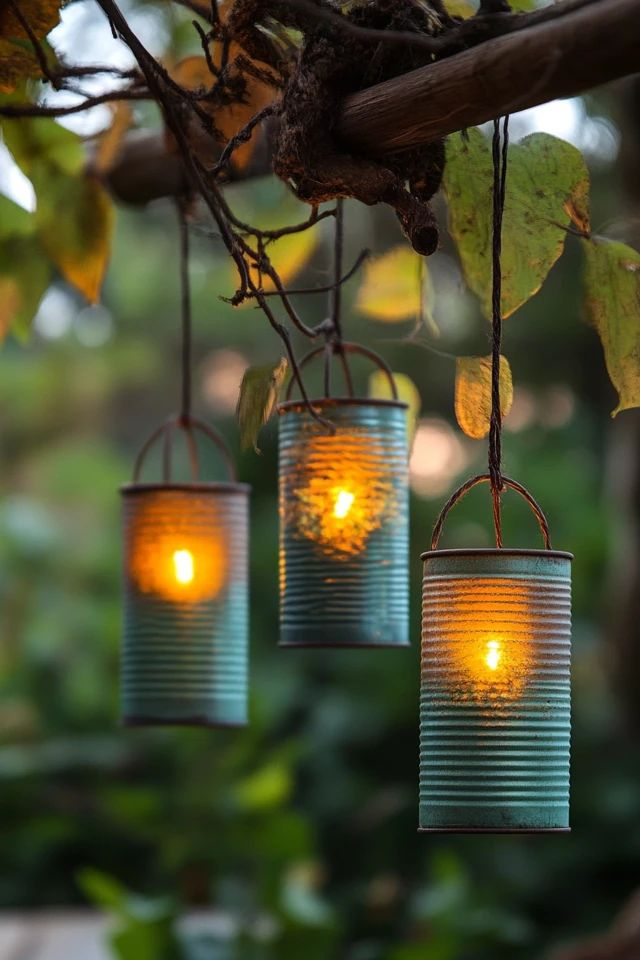
Recycled tin cans offer a multipurpose solution that doubles as rainfall guides and ambient lighting. By drilling patterned holes into the sides of cleaned, label-free cans, you can transform them into charming lanterns that glimmer when lit or catch light from the sun. Stack multiple cans vertically using sturdy chain links or wire, ensuring that each one slightly overlaps the next to allow rainwater to drip downward in a cascading fashion.
Mounted from the edge of a gutter, this handmade rain chain not only provides a decorative water flow path but also substitutes for traditional downspouts in a visually striking way. For evening ambience, place LED tea lights or waterproof fairy lights inside the cans. Some DIYers paint the exteriors in garden-matching shades or use stencils to add patterns.
To prevent rust, spray each can with a weather-resistant sealant, especially at the drilled holes. If placed near entryways or patios, they add a soft clinking sound during rainfall—enhancing the sensory appeal of your yard. This fusion of art and utility adds vertical interest, controls drainage with flair, and makes use of materials that would otherwise be discarded. It’s a sustainable choice that brings both beauty and function to your garden space.
Repurposed colander hanging planters

Colanders with their built-in drainage and perforated design make quirky yet functional hanging planters. Whether metal or plastic, these kitchen castoffs are ideal for planting shallow-root herbs, trailing succulents, or compact annuals. To begin, line the colander with coconut fiber or landscape fabric to hold soil while allowing water to drain freely. Fill it with well-aerated potting mix suited to your plant choice, then suspend using chain links, twine, or rope threaded through the colander handles.
When hung from tree limbs, shepherd’s hooks, or pergola beams, these upcycled planters introduce charm with a hint of whimsy. Their unique silhouette adds visual texture and breaks the monotony of traditional pots. You can spray-paint the colander in vibrant hues or let vintage enamel finishes show through for a farmhouse aesthetic.
Ideal for renters or small spaces, these hanging planters require no digging and can be moved around as seasons change. For added detail, embellish the handles with wooden beads or tie decorative fabric bows around the chains. With minimal effort and materials, colander planters bring vertical greenery into patios, balconies, and garden corners. They’re especially loved by urban gardeners seeking creative solutions that are both affordable and space-conscious.
Mosaic stepping‑stone pavers

Concrete pavers become pieces of outdoor art when embedded with mosaic designs. Using old plates, tiles, glass marbles, or broken pottery, you can transform plain stepping-stones into colorful paths that double as décor. Begin with premade cement pavers or mold your own using quick-set concrete. While the surface is still slightly wet, press your mosaic materials into the top in your desired pattern—geometric shapes, floral motifs, or even initials.
Apply a thin layer of grout once fully dried, wiping away excess to reveal clean outlines. Seal the stone with a weather-resistant topcoat for protection against rain and UV exposure. These stepping-stones are ideal for leading guests through flower beds, vegetable plots, or around raised garden beds.
Because each piece is handcrafted, no two stones look alike, offering a personalized touch to walkways or borders. They also make thoughtful gifts when customized with names, dates, or themed imagery. Kids enjoy helping with the design, making this a fun family-friendly DIY activity. Whether used sparingly as accents or arranged into full garden paths, mosaic stepping-stone pavers give the garden floor a splash of color and character without sacrificing durability or functionality.
Concrete orb garden accents

Smooth concrete spheres lend sculptural elegance to garden beds, patios, and entryway corners. Molded using inexpensive materials like playground balls or glass light globe covers, these orbs provide minimalist yet striking decor. Mix quick-set concrete with water until it reaches a thick but pourable consistency, then fill your mold evenly. Once fully cured—typically 24–48 hours—remove the mold and lightly sand any seams or rough edges.
Varying the size of each orb adds visual rhythm when grouped in threes or staggered throughout mulch beds. You can leave the concrete raw for a natural gray tone, or paint with exterior acrylics to match your landscape theme. Some gardeners stencil botanical patterns or spray with faux moss finish to help the orbs blend into more organic settings.
Because of their weight, these garden balls stay grounded through wind and weather. They also serve as visual anchors around water features, flower clusters, or open lawn space. For added interest, partial burial into the soil creates the illusion of larger submerged spheres. Durable and modern with just the right touch of whimsy, concrete orb accents add texture and permanence to outdoor designs without requiring much effort or ongoing maintenance.
Vintage chandelier planters

Retired chandeliers bring theatrical flair to garden spaces when transformed into cascading planters. Look for outdated or damaged light fixtures at thrift stores or garage sales—especially those with arm extensions or cup-style bulb holders. Begin by removing all wiring and glass components, ensuring only the metal frame remains. Replace bulb sockets with small terracotta pots or secure small bowls using waterproof adhesive.
Fill each mini planter with hardy succulents, shallow-root flowers, or seasonal annuals. Spray paint the frame in metallic or pastel shades for a cohesive look, and add weatherproof sealant to extend its life outdoors. Hang the finished piece from sturdy hooks, tree branches, or pergola beams, letting it spin slightly in the breeze.
During evenings, wrap the arms with solar-powered fairy lights to transform it into a soft-glow centerpiece. These planters work especially well over outdoor dining areas or tucked into secret garden corners. Lightweight yet visually commanding, they turn vertical space into something magical. By breathing new life into forgotten decor, vintage chandelier planters marry upcycling with elegance—offering show-stopping appeal while keeping waste out of landfills.
Painted garden sign stakes
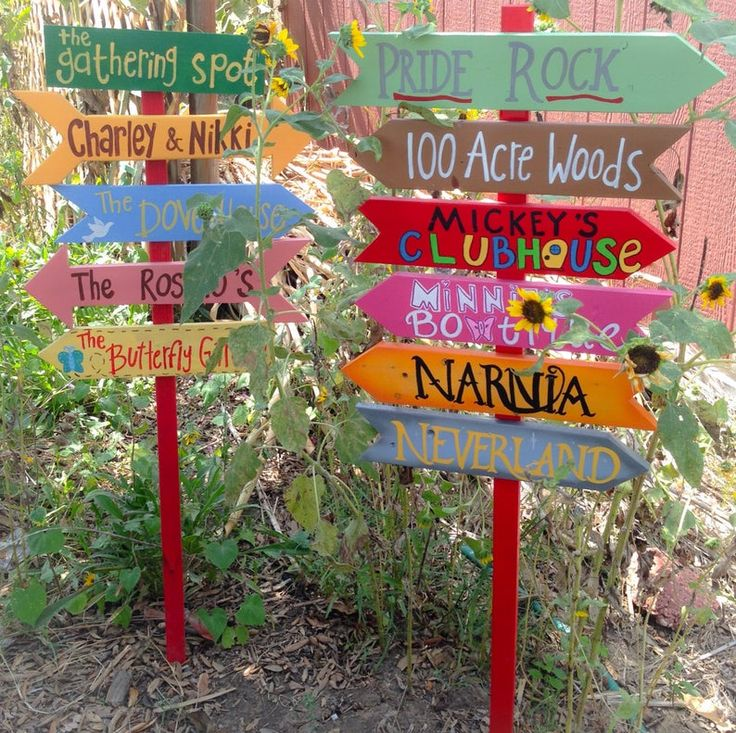
Weatherproof sign stakes add personality and practicality to any garden space. Crafted from reclaimed wood, pallet boards, or pre-cut cedar planks, these markers allow for customization in both message and style. Whether pointing guests to a seating nook, labeling different garden zones, or featuring cheeky quotes, painted signs bring clarity and character to your landscape.
Use exterior acrylic paint for lettering and decoration, sealing with a waterproof topcoat to ensure longevity. Mount the signs on sturdy wooden dowels, old broom handles, or metal rods, then stake them into soil beds, gravel paths, or next to raised beds. Choose fonts and colors that complement your garden’s aesthetic—boho, rustic, modern, or farmhouse.
Adding floral patterns, vines, or hand-drawn veggies around the edges personalizes each sign even further. Gardeners often rotate signs seasonally, introducing new messages to reflect blooming cycles or harvest times. Durable, budget-friendly, and full of charm, these signs are a go-to project for quick garden upgrades. Their straightforward construction also makes them ideal for beginners or family-friendly weekend crafts. From inspirational messages to practical directions, painted garden sign stakes strike a perfect balance between function and creativity.
Repurposed tire planters

Discarded tires become visually impactful, eco-conscious planters with just a little effort and creativity. Begin by thoroughly cleaning the surface, then apply several coats of exterior paint in vibrant hues or earth tones to complement your outdoor space. For safety and aesthetics, sand any rough edges or sharp wires before proceeding. These tires can be placed directly on the ground, stacked for a tiered effect, or hung from tree limbs to create dramatic hanging displays.
Line the interior with landscape fabric if needed, then fill with well-draining soil and your choice of plants—cascading vines, ornamental grasses, or flowering annuals work beautifully. Taller plants can thrive in stacked arrangements while trailing varieties spill over for a lush appearance. Some DIYers cut the upper rim into petal-like shapes, curling them outward to mimic oversized flowers, further enhancing visual interest.
Perfect for patios, backyards, or community garden projects, tire planters reduce landfill waste while offering structure and pop. Adding caster wheels can convert them into mobile garden features. With their rugged durability and weather resistance, repurposed tire planters serve as long-lasting art that supports sustainable gardening while allowing for endless customization. It’s a bold, functional project that merges reuse with standout design.
Glass‑bead orb sculptures
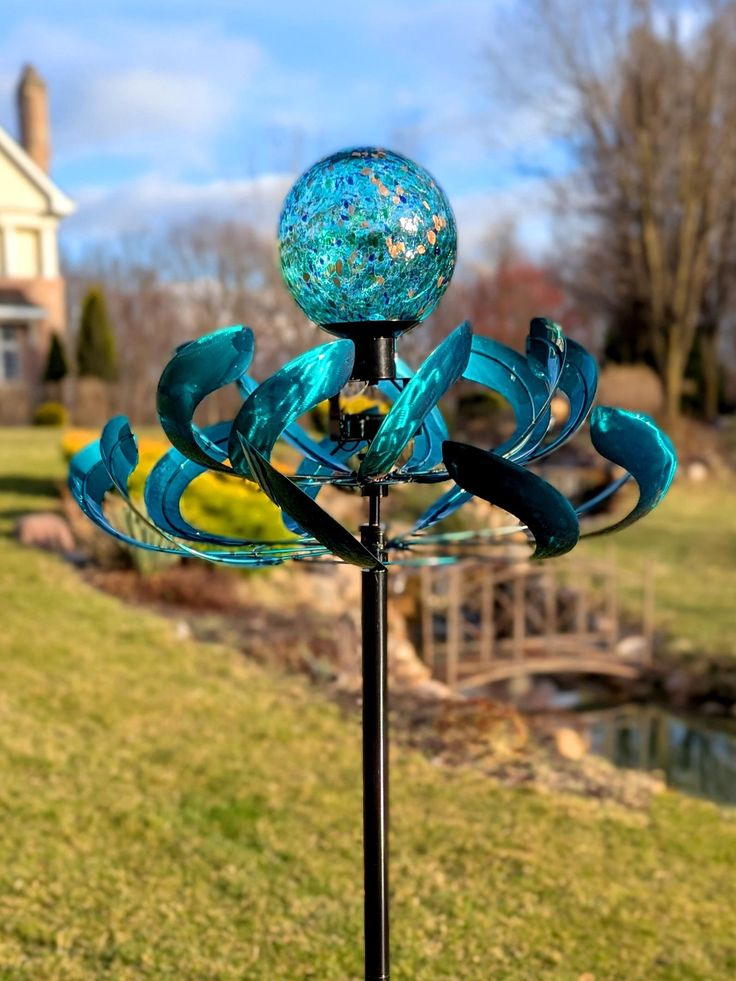
Sparkling orbs crafted from glass beads turn garden beds into luminous, jewel-like landscapes. Start with a styrofoam, glass, or concrete ball as a base, then adhere flat-backed glass marbles or decorative beads using strong outdoor adhesive. Arrange the beads tightly for full coverage, mixing sizes and colors for added depth and shimmer. Once dry, apply a waterproof sealant to lock everything in place.
Position these orb sculptures throughout flower beds, near fountains, or among low shrubs to reflect sunlight and glisten during golden hour. At night, they pick up ambient lighting or nearby solar path lights, extending their visual appeal into evening hours. You can also nestle them into planters or line them along pathways for whimsical accents.
This project is surprisingly beginner-friendly and yields professional-looking results with minimal investment. Using dollar-store supplies or leftover craft materials keeps costs low, while the end product mimics glass art you’d find in high-end garden boutiques. Whether used singly as highlights or grouped in clusters, glass‑bead orb sculptures offer a dazzling way to introduce light, color, and texture to your outdoor aesthetic in a completely weather-resistant and low-maintenance format.
Bottle‑tree art installations

Vivid bottle trees combine Southern folk tradition with bold color and cultural storytelling. Begin with a sturdy metal rod or welded tree-shaped stand, then mount empty glass bottles—typically blue, green, or clear—onto the branches with the necks facing down. These bottles are traditionally believed to trap evil spirits or negative energy, but even without the folklore, they make a stunning visual centerpiece in any garden.
Bottle trees can be minimalist or elaborate. Use salvaged rebar, fence posts, or repurposed branches as the frame. Space the bottles evenly to avoid overcrowding, and choose bottles of different shapes to add interest. You can keep the glass clear or spray paint them with frosted or colored finishes to play with light.
Placed in sunny locations, these installations catch and reflect daylight beautifully, adding sparkle and structure to open yards or entry paths. They also make striking statements in otherwise sparse winter gardens, where color and form are needed most. For extra creativity, some DIYers wrap fairy lights around the base or insert small solar lights inside the bottles. Low-maintenance and high-impact, bottle‑tree art installations bring energy, personality, and storytelling into outdoor living spaces.
Upcycled silverware butterfly art
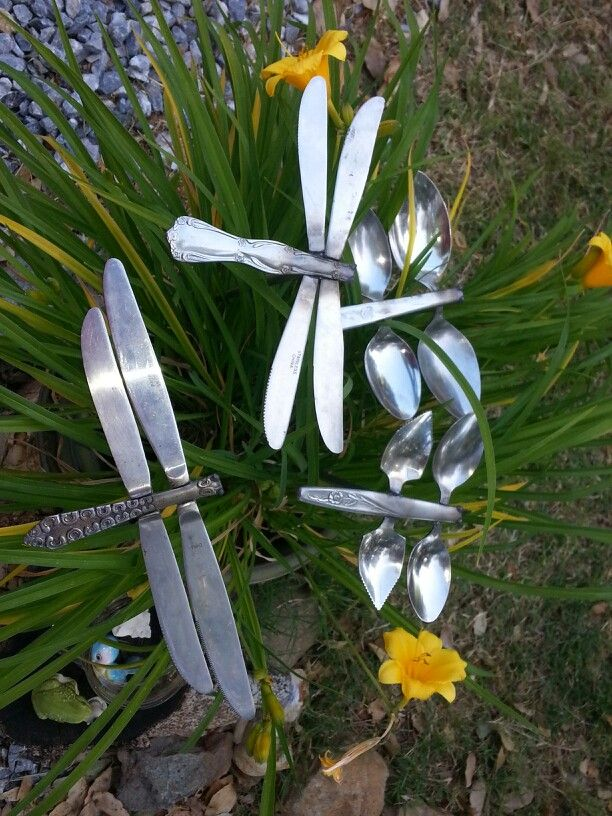
Old forks, knives, and spoons metamorphose into whimsical butterfly sculptures that perch beautifully in flower beds, fences, or potted arrangements. Use two spoons or flattened fork heads as the upper wings, and smaller cutlery pieces as the lower set. The handle of a knife or fork often serves as the body, with curled fork tines mimicking antennae. Welding or heavy-duty epoxy secures each piece in place for a solid, weather-resistant form.
Polishing the silverware beforehand adds sheen, or leave the patina for a rustic look. You can also paint the wings in metallic hues or use outdoor enamel paints for vivid, weatherproof designs. These butterflies look especially charming when affixed to garden stakes, trellises, or wooden posts, giving the illusion of flight above blooms and greenery.
Lightweight yet sturdy, silverware butterflies hold up well in outdoor conditions and bring a handmade, nostalgic feel to your space. Group them in odd numbers or mix with bee and dragonfly motifs to build out a metal garden menagerie. This creative reuse celebrates both form and function, transforming discarded household items into poetic, fluttering art that adds life and motion to every garden zone.
Metal flower stalk yard stakes

Recycled metal sheets, rods, and scrap tools serve as raw materials for handmade floral yard stakes that bring permanent blooms to any landscape. Begin by cutting petals from tin, aluminum, or copper sheeting, shaping them into layers and securing them together with rivets or welding. Add texture with hammering or embossing for petal veins and center details. Mount each bloom atop a sturdy metal rod or rebar stake for easy planting into the ground.
These sculptural flowers range from delicate daisy designs to bold sunflower or abstract art forms, depending on the material and your personal flair. Spray paint the finished piece in weather-resistant hues or let the metal age naturally into a rich patina. Placement near garden borders, along walkways, or flanking a vegetable plot instantly draws the eye and complements natural blooms.
Metal flower stakes stand strong against wind, rain, and time, providing reliable decoration through every season. Unlike live plants, they require no maintenance and remain vibrant year-round. For nighttime appeal, some gardeners attach solar lights or glow-in-the-dark paint to the petals. These durable, handmade garden accents blend rustic creativity with outdoor durability—offering a permanent splash of floral charm no matter the weather.
